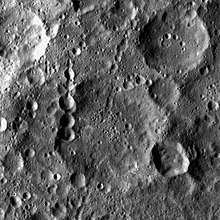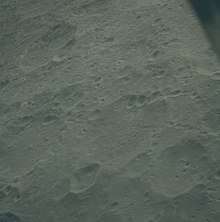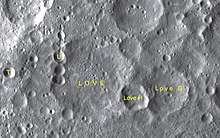Love (crater)
Love is an impact crater on the far side of the Moon. It was named after British mathematician and geophysicist Augustus Edward Hough Love.[1] It is located just to the north of the crater Perepelkin. Prager nearly touches the northeastern rim. To the northwest is Bečvář.
 LRO image | |
| Coordinates | 6.5°S 131.3°E |
|---|---|
| Diameter | 90.1 km |
| Depth | Unknown |
| Colongitude | 228° at sunrise |
| Eponym | Augustus E. H. Love |

This is an eroded crater formation with several smaller craters along the rim. A chain of three small craters lies across the western rim and inner wall, and a crater cuts across the eastern rim. The inner walls have been worn and their features softened by impacts and possibly ejecta from other craters. The northern portion of the interior floor contains a considerable number of small and tiny craterlets that nearly form a continuous carpet in places. The southern floor is less impacted, with only a few tiny craterlets.
Satellite craters

By convention these features are identified on lunar maps by placing the letter on the side of the crater midpoint that is closest to Love.
| Love | Latitude | Longitude | Diameter |
|---|---|---|---|
| G | 6.74° S | 131.72° E | 48.9 km |
| H | 6.9° S | 130.4° E | 32.5 km |
| T | 6.0° S | 126.1° E | 12.3 km |
| U | 5.9° S | 127.8° E | 12.1 km |
References
- "Love (crater)". Gazetteer of Planetary Nomenclature. USGS Astrogeology Research Program.
- Andersson, L. E.; Whitaker, E. A. (1982). NASA Catalogue of Lunar Nomenclature. NASA RP-1097.CS1 maint: ref=harv (link)
- Bussey, B.; Spudis, P. (2004). The Clementine Atlas of the Moon. New York: Cambridge University Press. ISBN 978-0-521-81528-4.CS1 maint: ref=harv (link)
- Cocks, Elijah E.; Cocks, Josiah C. (1995). Who's Who on the Moon: A Biographical Dictionary of Lunar Nomenclature. Tudor Publishers. ISBN 978-0-936389-27-1.CS1 maint: ref=harv (link)
- McDowell, Jonathan (July 15, 2007). "Lunar Nomenclature". Jonathan's Space Report. Retrieved 2007-10-24.CS1 maint: ref=harv (link)
- Menzel, D. H.; Minnaert, M.; Levin, B.; Dollfus, A.; Bell, B. (1971). "Report on Lunar Nomenclature by the Working Group of Commission 17 of the IAU". Space Science Reviews. 12 (2): 136–186. Bibcode:1971SSRv...12..136M. doi:10.1007/BF00171763.CS1 maint: ref=harv (link)
- Moore, Patrick (2001). On the Moon. Sterling Publishing Co. ISBN 978-0-304-35469-6.CS1 maint: ref=harv (link)
- Price, Fred W. (1988). The Moon Observer's Handbook. Cambridge University Press. ISBN 978-0-521-33500-3.CS1 maint: ref=harv (link)
- Rükl, Antonín (1990). Atlas of the Moon. Kalmbach Books. ISBN 978-0-913135-17-4.CS1 maint: ref=harv (link)
- Webb, Rev. T. W. (1962). Celestial Objects for Common Telescopes (6th revised ed.). Dover. ISBN 978-0-486-20917-3.CS1 maint: ref=harv (link)
- Whitaker, Ewen A. (1999). Mapping and Naming the Moon. Cambridge University Press. ISBN 978-0-521-62248-6.CS1 maint: ref=harv (link)
- Wlasuk, Peter T. (2000). Observing the Moon. Springer. ISBN 978-1-85233-193-1.CS1 maint: ref=harv (link)
External links
| Wikimedia Commons has media related to Love (lunar crater). |